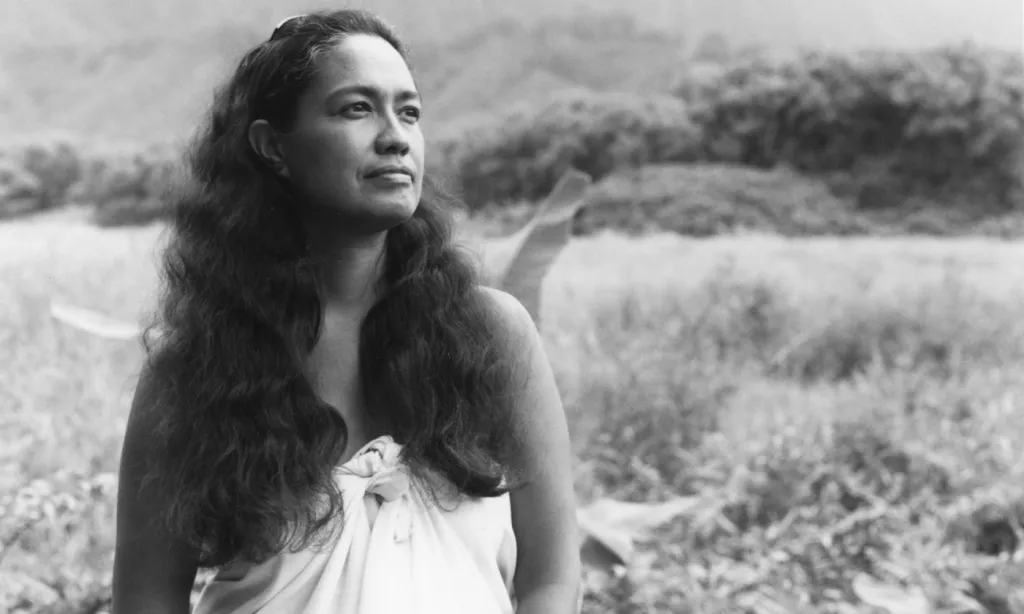 Anne Keala Kelly (Kānaka Maoli) is a filmmaker and journalist living on Hawai’i Island. Her works depict the critical links between cultural, film, and spiritual survival in the movement for Hawaiian self-determination and indigenous peoples’ struggles for territorial and environmental survival. She is an outspoken advocate for indigenous self-representation in mass media. Keala is a Ted Scripps Environmental Journalism Fellow and has an MFA from UCLA’s School of Theater, Film and Television. Her reporting and commentary have appeared in many publications, including Indian Country Today, The Nation, the Honolulu Civil Beat, and the Honolulu Weekly. For more information go to www.annekealakelly.com and www.nohohewa.com
Anne Keala Kelly (Kānaka Maoli) is a filmmaker and journalist living on Hawai’i Island. Her works depict the critical links between cultural, film, and spiritual survival in the movement for Hawaiian self-determination and indigenous peoples’ struggles for territorial and environmental survival. She is an outspoken advocate for indigenous self-representation in mass media. Keala is a Ted Scripps Environmental Journalism Fellow and has an MFA from UCLA’s School of Theater, Film and Television. Her reporting and commentary have appeared in many publications, including Indian Country Today, The Nation, the Honolulu Civil Beat, and the Honolulu Weekly. For more information go to www.annekealakelly.com and www.nohohewa.com
How Haunani-Kay Trask Shaped Her Hawai’ian People’s Struggle for Independence
OBITUARIES, 2 Aug 2021
Anne Keala Kelly (Kānaka Maoli) | YES! Magazine - TRANSCEND Media Service
The Hawaiian movement for self-determination was forever changed by the fierce and unapologetic leadership of the late Haunani-Kay Trask. This loving obituary written by one of Trask’s mentees explores her powerful legacy.
27 Jul 2021 – On July 3, 2021, the Hawaiian people lost one of our most important leaders in our movement for sovereignty. Haunani-Kay Trask passed away at age 71 in Honolulu. A writer, speaker, scholar, and poet, she was an uncompromising leader and the Director of the Department of Hawaiian Studies at the University of Hawaiʻi at Mānoa, now known as the Kamakakūokalani Center for Hawaiian Studies.In her life and work, she was fierce and articulate about the evils of American Empire and the need for Hawaiians to fight against its presence here. Now that she is gone, it is hard to imagine Hawai‘i without her. Back in the day, when Hawaiians were still living as Hawaiians, and someone died, part of our mourning ritual included the uwe, or kanikau. It is a wailing cry, and in old times it included a recitation of people and events in that person’s life. But that is not what this is. My words are too small.
To me, she will always be Haunani-Kay, a person I admired and came to know well, someone whose kindness and friendship was her way of mentoring me—a diaspora Hawaiian who came home and threw in with the movement. She always gave me interviews and was generous with her time. I was blessed to have laughed and argued politics with her, drinking too much wine when she took me to restaurants I could never afford. Cruising with Haunani-Kay was like riding shotgun with Aretha Franklin. No matter where we went, as we followed the maître d to the table, everyone turned to look at her. If they didn’t know who she was, they wanted to.
Haunani-Kay modeled for us how to analyze the U.S. overthrow of the Hawaiian Kingdom, our material reality, and American hegemony in the same frame.
Haunani-Kay remembered all the hewa (wrongs) done to generations of us. She was skilled at explaining the politics of greed, hypocrisy, and moral vacancy that motivated it. She embodied the righteousness of Hawaiian anger and resentment against settlers like a maestro, giving shape to the substance, encouraging insurgency, imploring Hawaiians at every turn to remember of ourselves that which has been dismembered by U.S. occupation. And the way she did it—with no trace of the polite and submissive Native Hawaiian that haole (White people) had grown to expect—shook the colonial establishment to its core.
Haunani-Kay’s defense of the word “haole” is excellent illustration of her uncompromising defense of Hawaiian rights. When a student at UH Mānoa wrote in the campus paper Ka Leo that the word “haole” was equivalent to the “N-word” her response set off a firestorm. Her suggestion that the student could always leave Hawaii led to the university president, the faculty senate, and the philosophy department calling for her removal as director of Hawaiian Studies.
She elevated Hawaiian Studies precisely because of her willingness to fight with the institution and the state. It went from a niche program working out of a few small offices to the Center for Hawaiian Studies, a beautiful set of buildings, next to a lo‘i kalo on its own part of the campus, and now offers a graduate degree.
In her book, From a Native Daughter: Colonialism and Sovereignty in Hawai‘i, Haunani-Kay took on the tourism industry and the “prostitution” of Hawaiian culture, the desecration, and ecocide committed by the U.S. military on Hawaiian land, and the haole-settler-colonial systems of power and economy.
None of our resistance discourse or protests would ever have taken place had she not done what she did.
She spoke out against a litany of abuses perpetrated against us, such as banning ʻŌlelo Hawaiʻi (Hawaiian language), congressionally determined identity via blood quantum rules, and the transformation of a place that had once sustained millions of Hawaiians over millennia into being 90% dependent on imported foods. She highlighted the shorter lifespans of Hawaiians, higher suicide rates, and our obscene over-representation in prison, poverty, and homelessness.
More broadly, Haunani-Kay modeled for us how to analyze the U.S. overthrow of the Hawaiian Kingdom, our material reality, and American hegemony in the same frame. Hers was a political mind formed by the anti-Imperialist movements of the 1960s and ’70s: the movement to end the Vietnam War, the Black Power Movement and Pan-Africanism, the Polynesian Panthers, and the American Indian Movement. Her close friendships with Albert Wendt, Angela Davis, Epeli Hau‘ofa, Ngũgĩ wa Thiong’o, and her decadeslong relationship with her life partner, professor David Stannard, also shaped her. She proudly kept a poster of Malcolm X in her office, and loved the Basques, the Irish, and the Palestinians, who she saw as heroic fighters for liberation from their oppressors.
To speak of Haunani-Kay and her impact on the Hawaiian people without recounting these political-historic markers would be like discussing Mohammad Ali without the words ‘Heavy Weight Champion of the World.’ And like Ali, Haunani-Kay was a fighter and a poet. Her first book of poetry, Light in the Crevice Never Seen, was the first such book by a Native Hawaiian to be published in North America. Filled with a vivid Hawaiian cultural and spiritual aesthetic, and fearless criticism of haole Americans in particular, the average non-Native reader might actually feel like they’re in the ring with Ali—which is why so many people reviled her. But for every one of them, a hundred Hawaiians revered her.
When I first learned of Haunani-Kay’s death, I was stunned, and that struck me as an odd reaction. Where was the relief I expected to feel? She had been in a care home for quite some time, and years before that she had withdrawn from public life. Though she did not discuss it openly, those near her knew during the decade before her retirement that something beyond her control was stealing her from us—and from herself—one memory at a time.
What are we, her people, to make of this space where our beloved leader once stood?
During the past 10 years, whether the subject was the fight over Mauna Kea or how to pressure the United Nations to intervene with regard to U.S. violations of our rights, I often wondered, “What would Haunani-Kay say?” And I asked other activists the same thing. None of our resistance discourse or protests would ever have taken place had she not done what she did. Even in her captive state, she was our true north, her illness mirroring the Hawaiian people’s experience: a devastatingly relentless process of being disappeared by a force we haven’t managed to stop.
When Haunani-Kay spoke in public, she floated up to the microphone like a beautiful butterfly, unleashing words that stung settlers like a million bees. Hers was the voice that once heard, no one could forget. In her most enduring speech given at ‘Iolani Palace on Jan. 17, 1993, on the 100th anniversary of the U.S. overthrow of Hawaii, she proclaimed, “We are not American! We are not American! We are not American! Say it in your hearts. Say it when you sleep! We are not American! We will die as Hawaiians. We will never be American!”
Thinking of her life as a whole, it is impossible to distinguish the extremes of how she lived and died from the metaphors in her poetry, the anti-colonial defiance of her politics, and her solidarity with her people. Kānaka Maoli (Native Hawaiians) and pae ‘āina (Hawai‘i), the people and the land, were inseparable in her mind, heart and soul. We meant everything to her. Indigenous nationalism, she said, in ‘Native Daughter, “is born not of a predatory consumption nor of murderous intolerance, but of a genealogical connection to our place, Hawai‘i.”
Haunani-Kay’s younger sister Mililani Trask, who was her co-engineer in many of the most important aspects of the Hawaiian Sovereignty Movement, posted one of her late sister’s poems from her book Night is a Sharkskin Drum, on Facebook after her death. It begins with the words, “Into the light I will go forever,” and ends with: “Into the wa‘a of Kanaloa, voyaging moana nui. Into our sovereign suns, drunk on the mana of Hawai‘i.” I want that vision of Haunani-Kay, sailing Oceania filled with the divine strength of her homeland, to become my new memory of her.
What are we, her people, to make of this space where our beloved leader once stood? I wonder what Haunani-Kay would say.
Together, for her, all we can say is, uwe. Uwe. Uwe. Uwe.
_____________________________________________
Go to Original – yesmagazine.org
Tags: Activism, Anglo America, Asia and the Pacific, Conflict, Coup, Cultural violence, Culture, Democracy, Development, Direct violence, Environment, Geopolitics, Haunani-Kay Trask, Hawaiian Culture, Hawaiian Religion, Hawaiian Sovereignty, History, Human Rights, Indigenous Rights, International Relations, Invasion, Justice, Nonviolence, Obituary, Occupation, Politics, Polynesian Culture, Regime Change, Solutions, Structural violence, UN, US Military, USA, Violence
DISCLAIMER: The statements, views and opinions expressed in pieces republished here are solely those of the authors and do not necessarily represent those of TMS. In accordance with title 17 U.S.C. section 107, this material is distributed without profit to those who have expressed a prior interest in receiving the included information for research and educational purposes. TMS has no affiliation whatsoever with the originator of this article nor is TMS endorsed or sponsored by the originator. “GO TO ORIGINAL” links are provided as a convenience to our readers and allow for verification of authenticity. However, as originating pages are often updated by their originating host sites, the versions posted may not match the versions our readers view when clicking the “GO TO ORIGINAL” links. This site contains copyrighted material the use of which has not always been specifically authorized by the copyright owner. We are making such material available in our efforts to advance understanding of environmental, political, human rights, economic, democracy, scientific, and social justice issues, etc. We believe this constitutes a ‘fair use’ of any such copyrighted material as provided for in section 107 of the US Copyright Law. In accordance with Title 17 U.S.C. Section 107, the material on this site is distributed without profit to those who have expressed a prior interest in receiving the included information for research and educational purposes. For more information go to: http://www.law.cornell.edu/uscode/17/107.shtml. If you wish to use copyrighted material from this site for purposes of your own that go beyond ‘fair use’, you must obtain permission from the copyright owner.
